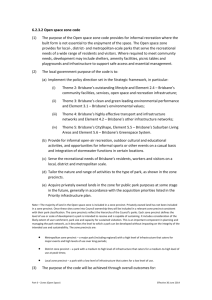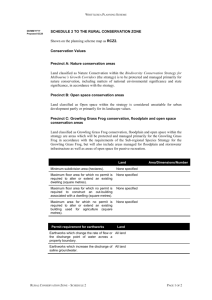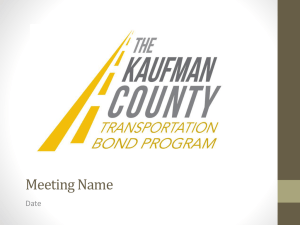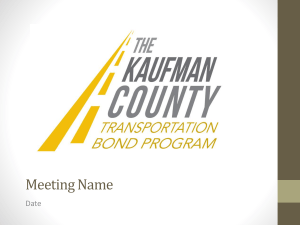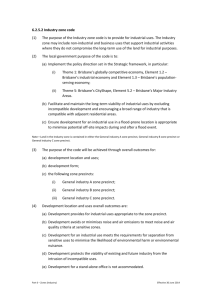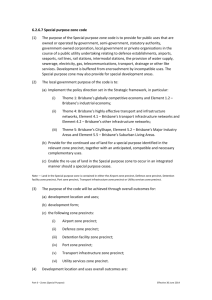Conservation zone code - Brisbane City Council
advertisement
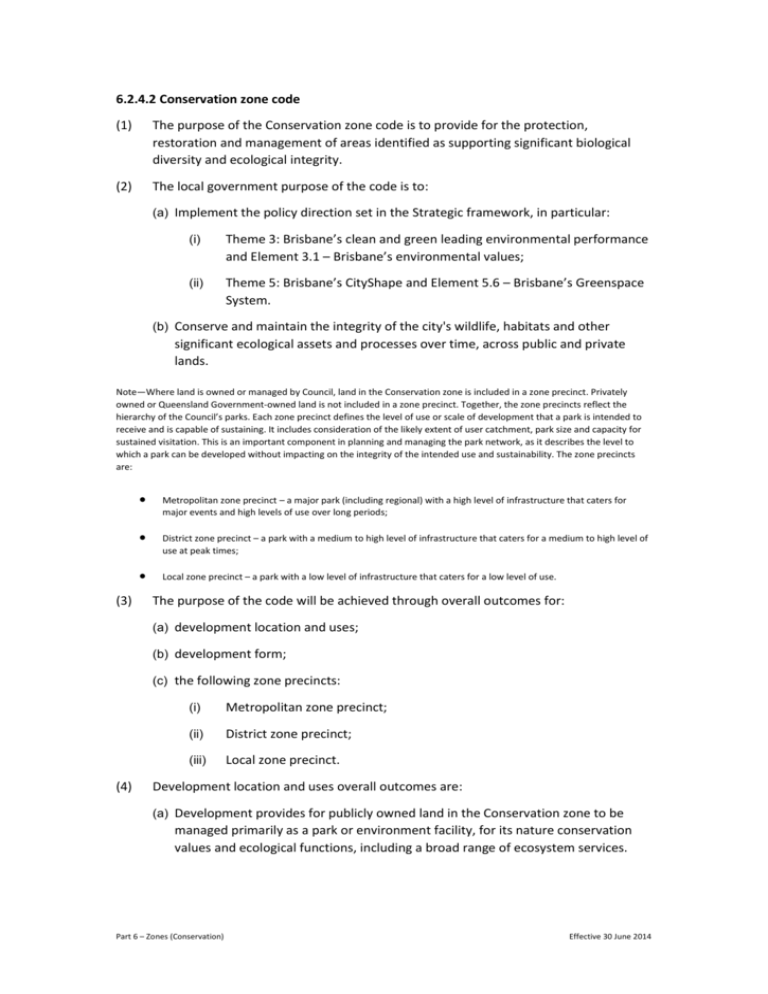
6.2.4.2 Conservation zone code (1) The purpose of the Conservation zone code is to provide for the protection, restoration and management of areas identified as supporting significant biological diversity and ecological integrity. (2) The local government purpose of the code is to: (a) Implement the policy direction set in the Strategic framework, in particular: (i) Theme 3: Brisbane’s clean and green leading environmental performance and Element 3.1 – Brisbane’s environmental values; (ii) Theme 5: Brisbane’s CityShape and Element 5.6 – Brisbane’s Greenspace System. (b) Conserve and maintain the integrity of the city's wildlife, habitats and other significant ecological assets and processes over time, across public and private lands. Note—Where land is owned or managed by Council, land in the Conservation zone is included in a zone precinct. Privately owned or Queensland Government-owned land is not included in a zone precinct. Together, the zone precincts reflect the hierarchy of the Council’s parks. Each zone precinct defines the level of use or scale of development that a park is intended to receive and is capable of sustaining. It includes consideration of the likely extent of user catchment, park size and capacity for sustained visitation. This is an important component in planning and managing the park network, as it describes the level to which a park can be developed without impacting on the integrity of the intended use and sustainability. The zone precincts are: (3) Metropolitan zone precinct – a major park (including regional) with a high level of infrastructure that caters for major events and high levels of use over long periods; District zone precinct – a park with a medium to high level of infrastructure that caters for a medium to high level of use at peak times; Local zone precinct – a park with a low level of infrastructure that caters for a low level of use. The purpose of the code will be achieved through overall outcomes for: (a) development location and uses; (b) development form; (c) the following zone precincts: (4) (i) Metropolitan zone precinct; (ii) District zone precinct; (iii) Local zone precinct. Development location and uses overall outcomes are: (a) Development provides for publicly owned land in the Conservation zone to be managed primarily as a park or environment facility, for its nature conservation values and ecological functions, including a broad range of ecosystem services. Part 6 – Zones (Conservation) Effective 30 June 2014 (b) Development opportunities are limited to sustainable outdoor recreation and educational activities that are provided for on public land in accordance with a best-practice planning and management framework. (c) Development for housing comprises a 1 or 2 storey dwelling house which is: (i) on private land; (ii) part of a nature conservation partnership program; (iii) located on an agreed portion of the site; (iv) sited to respect the environmental values and identity of the Conservation zone. (d) Development for a home based business may operate in a dwelling house and is of a scale and nature that protects the amenity of adjoining residents. (e) Development provides for the restoration of wildlife habitat and associated features to occur through active rehabilitation and management of biosecurity threats on land which functions as a receiving site for biodiversity offsets. (5) Development form overall outcomes are: (a) Development adopts and promotes sustainable operational features and practices, including climate responsiveness and water conservation. (b) Development protects the values and function of the Conservation zone through innovative design, planning and construction approaches, including application of noise, light and physical buffers external to the values being conserved. (c) Development of a small-scale non-residential use of food and drink outlet, landing or outdoor sport and recreation is accommodated in the District zone precinct and the Metropolitan zone precinct where it supports the nature-based experience of the Conservation zone and does not undermine nature conservation values. (d) Development responds to land constraints, mitigates any adverse impacts on environmental values and addresses other specific characteristics, as identified by overlays affecting the site or in codes applicable to the development. (6) Metropolitan zone precinct overall outcomes are: (a) Development provides a park setting that will attract and cater for users from across the Brisbane metropolitan area. (7) District zone precinct overall outcomes are: (a) Development provides a park setting that will attract and cater for users from a district (i.e. 2 to 3 suburbs, area with a radius of approximately 2km). (8) Local zone precinct overall outcomes are: (a) Development provides a park setting that will attract and cater for users from a local area (i.e. 1 suburb, area with a radius of approximately 500m). Part 6 – Zones (Conservation) Effective 30 June 2014 Editor’s note—Opportunities are provided for private landowners to participate in nature conservation partnership programs that support the purpose of the Conservation zone code. Part 6 – Zones (Conservation) Effective 30 June 2014


